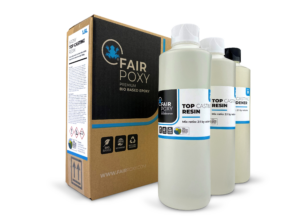Why choose Fairpoxy?
The use of renewable resources such as rapeseed seed and coconut instead of fossil resources has a positive impact on the carbon footprint of epoxy making it a lot more environmentally friendly than other epoxies. In addition, Fairpoxy bio based epoxy is a USDA certified product that is included in the USDA BioPreferred program and is a member of the European Greentech Alliance. Fairpoxy bio based epoxy is produced in the Benelux which means that transport from factory and to customer generates a smaller carbon footprint than imports from other countries; the packaging is completely recyclable.
How to use Fairpoxy laminating resin?
The processing time (pot life) is about 25 minutes at 20 degrees. So don’t make more epoxy at a time than you can process for 25 minutes. For transparent applications, we recommend adding UV blocker to prevent yellowing from sunlight in the long run.
Laminating
Lamination is the use of fabrics in combination with epoxy. By laminating, you can strengthen structures and make them stiffer. Consider, for example, a boat hull or surfboard. Glass fabrics or bio based flax fabrics are usually used for this purpose. For extra stiff or strong results, you can also use carbon or aramid fabrics. Fairpoxy laminating resin is suitable for laminating with glass fabric, carbon fabric, flax and aramid fabric.
Coating
Coating works the same as painting. After sanding and degreasing the surface with for example bio degreaser, apply the mixed epoxy with a brush or roller. For coating there is a consumption of approx. 250gr per m2 per layer. For hot coating and gloss coating in thicker layers use Fairpoxy Top Casting resin.
If you want to apply several coats, you can do so “wet in wet”. This means that when the first layer of epoxy cures, the next layer can already be applied so you don’t have to sand and degrease in between. The next layer can be applied after about 4 hours. If you wait longer than 24 hours you will have to sand and degrease between coats.
Adhesives
By adding fillers to the epoxy, a nice filling epoxy adhesive can be made. Depending on the application, you can adjust the epoxy to the thickness of jam to peanut butter. The most commonly used fillers for bonding with epoxy are cotton fiber, aerosil or stewathix and sustainable products such as Olive Stone powder of Bamboo dust.
Putty
An epoxy putty must be feather light, easily sandable and, of course, completely waterproof. You achieve this by mixing glass bubbles or olive stone powder through the epoxy.








